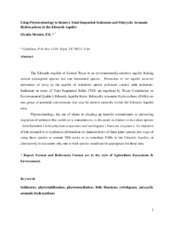| dc.creator | Mercier, Glynda | |
| dc.date.accessioned | 2016-06-17T17:01:11Z | |
| dc.date.available | 2016-06-17T17:01:11Z | |
| dc.date.issued | 2016-06-17 | |
| dc.identifier.uri | https://hdl.handle.net/1969.1/156677 | |
| dc.description.abstract | The Edwards Aquifer of Central Texas is an environmentally-sensitive aquifer hosting several endangered species and one threatened species. Protection of the aquifer involves prevention of entry to the aquifer of sediments and/or pollutants carried with sediments. Sediments in terms of Total Suspended Solids (TSS) are regulated by Texas Commission on Environmental Quality’s Edwards Aquifer Rules. Polycyclic Aromatic Hydrocarbons (PAHs) are one group of potential contaminants that may be present currently within the Edwards Aquifer area.
Phytotechnology, the use of plants in cleaning up harmful contaminants or preventing migration of sediment that could carry contaminants, is discussed in relation to two plant species - little bluestem ( Schizachyrium scoparium) and switchgrass ( Panicum virgatum ). An objective of this research is to synthesize information on characteristics of these plant species into ways of using these species to contain TSS onsite or to remediate PAHs in the Edwards Aquifer, or alternatively to document why one or both species would not be appropriate for these uses. | en |
| dc.language.iso | en_US | |
| dc.relation.ispartofseries | Wildlife;5 | |
| dc.subject | Sediments; phytostabilization; phytoremediation; little bluestem; switchgrass; polycyclic aromatic hydrocarbons | en |
| dc.title | Using Phytotechnology to Remove Total Suspended Sediments and Polycyclic Aromatic Hydrocarbons in the Edwards Aquifer | en |
| dc.type | Other | en |
| local.department | Wildlife and Fisheries Sciences | en |


